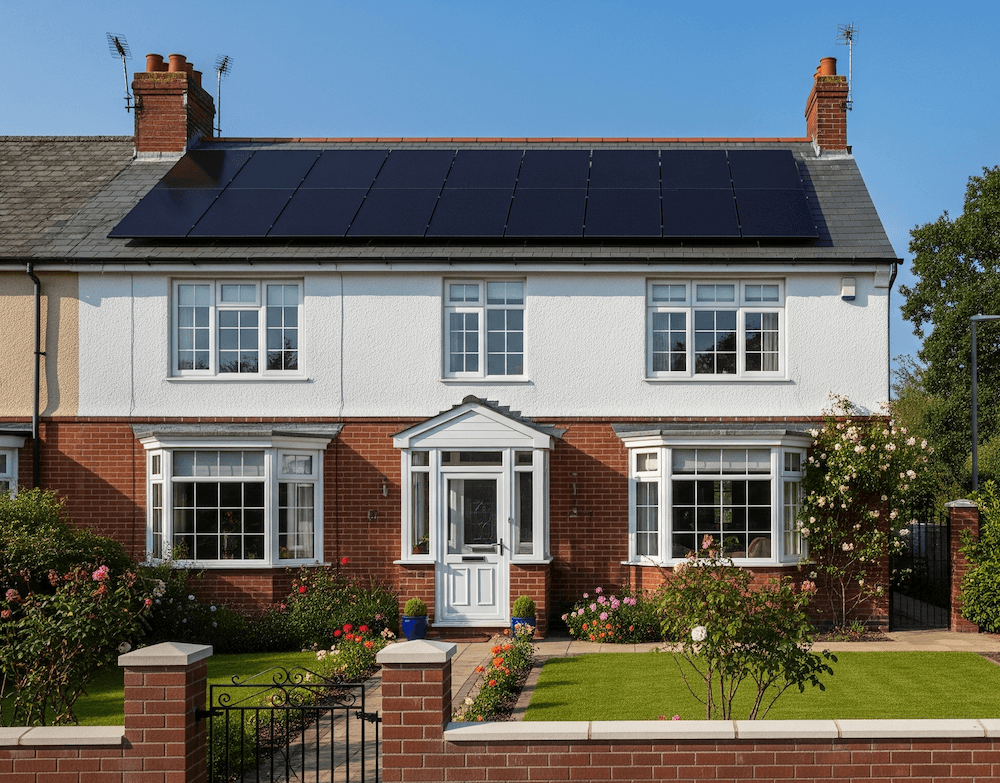Britain’s sunniest spring supercharged home solar
What does greater solar generation mean for your house-hold?
by David Lewis | published 26 August 2025
Spring 2025 didn’t just feel bright – it shattered records and lifted UK rooftop solar to new heights. The Met Office confirms the UK clocked 653.3 hours of sunshine from 1 March to 31 May (that’s 43% above average), making it the sunniest spring since records began in 1910, and also the warmest on record.
That sunshine translated directly into electricity. New analysis shows UK solar (farms and rooftops) generated a record 7.6 TWh in January to May 2025, up 42% year-on-year. For the first time, solar topped 10% of monthly UK electricity in April and May, with a half-hourly peak of 13.2 GW at lunchtime on 6 April.

Key numbers at a glance
- Sunshine hours (March to May): 653.3 (record high; +43% vs average)
- Solar generation (January to May): 7.6 TWh (+42% YoY)
- Share of UK electricity: >10% in April & May (first back-to-back months)
- Instantaneous record: 13.2 GW at 13:00, 6 April
Why it happened
- The weather really was exceptional: Persistent high-pressure systems brought long, bright days and very little rain, delivering the sunniest and warmest spring on record across the UK.
- There’s more solar on roofs and in fields: Installed capacity has been climbing again – roughly 20 GW by the end of 2024, with expectations of 45-47 GW by 2030. Early 2025 also saw a surge in new rooftop installs, the strongest start to a year since 2012.
- Panels performed better than usual: With brighter skies, solar’s capacity factor (how hard panels work on average) set new spring highs, pushing up monthly generation records in April and May.
What this means if you have (or are considering) home solar
Bigger midday surplus
The April peak shows how quickly rooftops can flood the grid around lunchtime. If your home already has solar PV panels, you likely saw higher midday exports this spring. Pairing solar panels with a battery lets you store that cheap/“free” power for the evening peak. Grid analysts expect more days like this, making storage increasingly valuable.
Bills and payback
With electricity unit rates still elevated in 2025, independent analyses suggest faster paybacks on well-sized rooftop systems.
Tariff strategy matters
High spring generation plus smart tariffs can sharpen savings. When solar output is strong, export payments and time-of-use charging windows can make a meaningful difference to your annual bill. (Check your supplier’s T&Cs and metering requirements.)
Electrify more of the home
Using excess solar to heat water (diverters), charge an EV, or pre-heat with a heat pump increases self-consumption – the single biggest lever on household savings.
The grid picture: opportunity and growing pains
Record sunshine is good news, but it also creates engineering challenges on ultra-sunny days: demand at the transmission level can dip very low at midday, and the system operator may need more flexibility (batteries, interconnectors, demand-shifting) to keep everything stable. Expect policy and market tweaks that reward households and businesses for storing or shifting energy when the sun is strongest.
Why this spring likely isn’t a one-off
Long-term Met Office data show UK springs have become warmer and sunnier over recent decades, and seven of the ten sunniest UK springs since 1910 have occurred since 2000. While year-to-year weather always varies, the trend boosts average solar yields over time – especially for well-oriented rooftops.
Bottom line
Spring 2025 set sunshine and warmth records, and solar responded in kind, breaking generation records and crossing 10% of monthly electricity two months running.
For households, the takeaway is practical: size your system for your usage, add storage if you can, and pick tariffs that fit your pattern. The brighter Britain gets, the more home solar pays its way.
